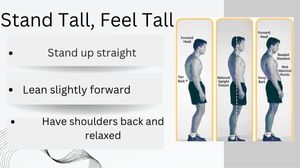Body Language in the Workplace: 10 Powerful Tips to Make a Strong First Impression
Use these ten professional body language strategies to become an expert in the workplace. Discover how to create a memorable first impression, increase your charm and confidence, and get practical tips and top product choices.
Body Language in the Workplace: How to Make a Strong First Impression
Particularly in the professional setting, first impressions matter a lot. Your body language greatly influences how people see you, whether you’re engaging with coworkers, meeting a potential client, or attending a job interview. Gaining control of your body language may greatly increase your charisma and self-assurance, helping you to stand out in a professional situation.
Now we’ll go into how to master body language in the workplace with 10 powerful tips. In addition, we’ll recommend some vital resources and books from Amazon and other affiliate networks that will aid you in developing your body language skills.
1. The Power of a Strong Handshake: Setting the Tone for Success
The first physical touch in a professional situation is frequently a handshake. It might convey assurance, dependability, and professionalism. On the other side, an excessively forceful or feeble handshake may convey the incorrect idea.
Advice for Handshake:
Firm, not forceful: Your handshake should be sufficiently firm to project confidence without coming across as oppressive.
Eye contact is key: When shaking hands, always look the other person in the eye.
Smile: A sincere grin might improve the positive vibe of the handshake.
Product Recommendation: “The Definitive Book of Body Language” by Allan and Barbara Pease is a recommended product. a thorough manual for comprehending and becoming proficient in the nuances of body language, including handshakes.
2. Eye Contact: The Gateway to Building Trust
Making eye contact is one of the best ways to establish rapport and trust in the workplace. It demonstrates your self-assurance, focus, and involvement.
Guidelines for Maintaining Eye Contact:
It’s important to maintain balance: Achieving the ideal mix between approachability and confidence during a discussion requires maintaining eye contact for roughly 60–70% of the exchange.
Avoid staring: Pay attention to how long you make eye contact as it can be interpreted as aggressive.
Use the triangle technique: To prevent staring, concentrate on one eye, then the other, and lastly the lips in a soft triangle pattern.
Product Recommendation: Bringing Your Boldest Self to Your Biggest Challenges” by Amy Cuddy is the recommended product. Find out how your presence and productivity at work can be impacted by your body language, especially your eye contact.
3. Posture: Stand Tall, Project Confidence
Your power and confidence are subtly conveyed through your stance. Maintaining a straight spine when sitting or standing conveys confidence and control.
Advice for a Self-Assured Position:
Align your body: Maintain a straight head, neck, and spine, along with relaxed shoulders.
Weight distribution: To project stability, stand with your weight equally distributed over both feet.
Power posing: To increase your confidence, perform power poses before significant meetings or presentations.
Product Recommendation: The “Your Best Life Portable Posture Corrector” is a straightforward tool that can assist you in keeping your posture straight throughout the day, enhancing your confidence and general well-being.
4. Your Emotions Visible in Your Facial Expressions
People frequently pick up on your facial expressions first, and they can indicate a variety of feelings, from confidence to dread.
Suggestions for Gratitude on Your Face:
Sincere smile: You might come off as more friendly and likeable right away with a warm, sincere grin.
Mind your resting face:Watch how your face looks when you’re at rest to make sure it’s not too serious or distant.
Mirror others: Building rapport and connection with someone you’re speaking to might be achieved by subtly copying their facial expressions.
Product Recommendation: “Emotions Revealed: Recognizing Faces and Feelings to Improve Communication and Emotional Life” by Paul Ekman is the recommended product. a book that explores the communication-related science of facial expressions.
5. Gestures: Enhance Your Communication
Using hand gestures to communicate can greatly improve your conversation by projecting a more lively and involved image. To prevent distractions, it’s crucial to employ gestures correctly.
Suggestions for Powerful Motions:
Use open palm gestures: Make use of open palm motions to convey honesty and transparency, which can increase your perceived trustworthiness.
Do not fidget: Fidgeting can give the impression that you are unsure or unprepared. Make sure every step you take has a purpose.
Match gestures with your words: To bolster your message, make motions that correspond with what you say.
Product Suggestion: Carol Kinsey Goman’s “The Silent Language of Leaders: How Body Language Can Help – or Hurt – How You Lead” This book provides guidance on how leaders can communicate more effectively by using their body language, including gestures.
6. Mirroring: Building Rapport Subtly
Establishing Context Gently Reflecting is an effective way to establish a good rapport in the office. You can establish a connection and mutual understanding by gently copying the other person’s body language.
Advice for Mirroring:
Be subtle: Without being overt, mimic the other person’s posture, gestures, or tone.
Start small: As the conversation goes on, progressively increase the number of gestures you mirror.
Combine with verbal mirroring: To strengthen the bond, use comparable words or expressions.
Product Recommendation:”The Like Switch: An Ex-FBI Agent’s Guide to Influencing, Attracting, and Winning People Over” is a product that Jack Schafer suggests. a manual for establishing solid relationships in any situation by utilizing psychological concepts, such as mirroring.
7. Personal Space: Respecting Boundaries
In a business setting, knowing your own space is essential. While keeping the appropriate distance from someone demonstrates respect and consideration, invading their personal space might make them feel uncomfortable.
Advice on Keeping Your Own Space:
Know the zones: While personal distance (1.5–4 feet) is suitable for close friends or coworkers, social distance (4–12 feet) is suitable for acquaintances.
Watch for cues: To determine how comfortable someone is, observe their body language.
Adjust accordingly: Give someone more room to feel comfortable if they take a step back.
Product Recommendation: Elizabeth Kuhnke’s “Body Language for Dummies” is a recommended product. A useful manual for comprehending and controlling body language, which covers the idea of personal space.
8. Voice Tone: Use Warmth and Authority When Speaking
Although most body language is non-verbal, the way you speak matters a lot when communicating. An appropriate tone can exude warmth, confidence, and authority.
Advice for a Voice with an Effective Tone:
Reduce the pitch: People tend to view a lower pitch as more certain and powerful.
Make good use of your pauses. You can increase the impact of your speech by adding emphasis and pausing before making a point.
Vary your tone: To keep things interesting, change up the tone you use.
Product Recommendation:”Talk Like TED: The 9 Public-Speaking Secrets of the World’s Top Minds” by Carmine Gallo is a recommended product. Develop your voice skills so you can enthrall and persuade people.
9. Dress for Success: The Visual Impact of Your Appearance
One important aspect of your body language is how you look. How you present yourself to others has a big impact on how you dress for the job.
Suggestions for Successful Outfits:
Dress for the role you want: What you wear should be consistent with the polished image you wish to convey.
Be mindful of the details: You can convey that you are concerned about your look with well-groomed hair, shiny shoes, and wrinkle-free, clean clothes.
Choose colors wisely: Different meanings can be conveyed by different hues; for example, black can signify authority, blue trust, etc.
Product Suggestion: “The New Professional Image: Dress Your Best for Every Business Situation” written by Susan Bixler – a how-to guide on dressing to project a strong, polished image.
10. The Impact of Physical Presence: Commanding the Room
How you arrive, stand, and move in a space can have a lasting impact on how people perceive you physically. It takes more than simply your size to command a room; you also need to exude confidence and authority.
Advice on Establishing a Commanding Presence:
Come with a purpose: Enter a room with a confident, purposeful gait that is strong and deliberate.
Take more room: By taking up more space when you stand or sit, you might project an air of confidence and authority.
Pay attention to how you move: Keep your movements small and deliberate to avoid coming across as uncertain.
Product Recommendation: Sylvia Ann Hewlett’s book “Executive Presence: The Missing Link Between Merit and Success” is a recommended read. a book that delves into the components of executive presence—physical presence included—that can support your career success.
Conclusion: Developing Your Body Language Skills for Success at Work
Building enduring professional relationships and creating a good first impression at work require understanding body language. You may greatly increase your confidence and charisma in any professional context by concentrating on these ten essential areas: handshakes, eye contact, posture, facial expressions, gestures, mirroring, personal space, tone of voice, appearance, and physical presence.
Best Books and Products on Amazon for Ongoing Education:
Allan and Barbara Pease’s “The Definitive Book of Body Language”
Amy Cuddy’s “Presence”
* “Portable Posture for Your Best Life”
Come with a purpose: Enter a room with a confident, purposeful gait that is strong and deliberate.
Take more room: By taking up more space when you stand or sit, you might project an air of confidence and authority.
Be aware of your movements: Steer clear of tiny, timid movements that could give the impression that you are unsure.










